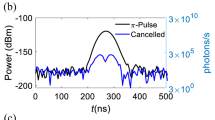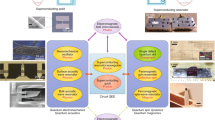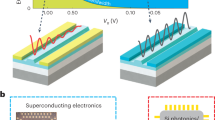Abstract
Single-electron transport relates an operation frequency f to the emitted current I through the electron charge e as I = ef (refs. 1,2,3,4,5). Similarly, direct frequency-to-power conversion (FPC) links both quantities through a known energy. FPC is a natural candidate for a power standard resorting to the most basic definition of the watt: energy emitted per unit of time. The energy is traceable to Planck’s constant and the time is in turn traceable to the unperturbed ground state hyperfine transition frequency of the caesium 133 atom. Hence, FPC comprises a simple and elegant way to realize the watt6. In this spirit, single-photon emission7,8 and detection9 at known rates have been proposed as radiometric standards and experimentally realized10,11,12,13,14. However, power standards are so far only traceable to electrical units, that is, to the volt and the ohm6,15,16,17. In this Letter, we demonstrate an alternative proposal based on solid-state direct FPC using a hybrid single-electron transistor (SET). The SET injects n (integer) quasi-particles (QPs) per cycle into the two superconducting leads with discrete energies close to their superconducting gap Δ, even at zero source-drain voltage. Furthermore, the application of a bias voltage can vary the distribution of the power among the two leads, allowing for an almost equal power injection nΔf into the two. While in single-electron transport current is related to a fixed universal constant (e), in our approach Δ is a material-dependent quantity. We estimate that under optimized conditions errors can be well below 1%.
This is a preview of subscription content, access via your institution
Access options
Access Nature and 54 other Nature Portfolio journals
Get Nature+, our best-value online-access subscription
$29.99 / 30 days
cancel any time
Subscribe to this journal
Receive 12 print issues and online access
$259.00 per year
only $21.58 per issue
Buy this article
- Purchase on Springer Link
- Instant access to full article PDF
Prices may be subject to local taxes which are calculated during checkout




Similar content being viewed by others
Data availability
Data supporting the manuscript and supplementary figures as well as further findings are available at https://doi.org/10.5281/zenodo.5727157 (ref. 34). Source data are provided with this paper.
Code availability
The codes for generating the measured manuscript and supplementary figures are available at https://doi.org/10.5281/zenodo.5727157 (ref. 34). Algorithms for generating calculated curves are available from the corresponding author upon reasonable request.
References
Geerligs, L. J. et al. Frequency-locked turnstile device for single electrons. Phys. Rev. Lett. 64, 2691–2694 (1990).
Kouwenhoven, L. P., Johnson, A. T., van der Vaart, N. C., Harmans, C. J. P. M. & Foxon, C. T. Quantized current in a quantum-dot turnstile using oscillating tunnel barriers. Phys. Rev. Lett. 67, 1626–1629 (1991).
Pekola, J. P. et al. Hybrid single-electron transistor as a source of quantized electric current. Nat. Phys. 4, 120–124 (2007).
Pekola, J. P. et al. Single-electron current sources: Toward a refined definition of the ampere. Rev. Mod. Phys. 85, 1421–1472 (2013).
Kaestner, B. & Kashcheyevs, V. Non-adiabatic quantized charge pumping with tunable-barrier quantum dots: a review of current progress. Rep. Prog. Phys. 78, 103901 (2015).
BIPM. Mise en Pratique For The Definition Of The Ampere and Other Electrical units in the SI. Appendix 2 9th edn (Bureau International des Poids et Mesures, 2019); https://www.bipm.org/en/publications/mises-en-pratique
Vaigu, A. et al. Experimental demonstration of a predictable single photon source with variable photon flux. Metrologia 54, 218–223 (2017).
Rodiek, B. et al. Experimental realization of an absolute single-photon source based on a single nitrogen vacancy center in a nanodiamond. Optica 4, 71–76 (2017).
Zhu, D. et al. Resolving photon numbers using a superconducting nanowire with impedance-matching taper. Nano Lett. 20, 3858–3863 (2020).
Zwinkels, J. C., Ikonen, E., Fox, N. P., Ulm, G. & Rastello, M. L. Photometry, radiometry and ‘the candela’: evolution in the classical and quantum world. Metrologia 47, R15–R32 (2010).
Chunnilall, C. J., Degiovanni, I. P., Kück, S., Müller, I. & Sinclair, A. G. Metrology of single-photon sources and detectors: a review. Opt. Eng. 53, 081910 (2014).
Lemieux, S., Giese, E., Fickler, R., Chekhova, M. V. & Boyd, R. W. A primary radiation standard based on quantum nonlinear optics. Nat. Phys. 15, 529–532 (2019).
Saha, S., Jaiswal, V. K., Sharma, P. & Aswal, D. K. Evolution of SI base unit candela: Quantifying the light perception of human eye. MAPAN 35, 563–573 (2020).
Tomm, N. et al. A bright and fast source of coherent single photons. Nat. Nanotechnol. 16, 399–403 (2021).
Palafox, L., Ramm, G., Behr, R., Ihlenfeld, W. K. & Moser, H. Primary AC power standard based on programmable Josephson junction arrays. IEEE Trans. Instrum. Meas. 56, 534–537 (2007).
Waltrip, B. et al. AC power standard using a programmable Josephson voltage standard. IEEE Trans. Instrum. Meas. 58, 1041–1048 (2009).
Waltrip, B. C., Nelson, T. L., Berilla, M., Flowers-Jacobs, N. E. & Dresselhaus, P. D. Comparison of AC power referenced to either PJVS or JAWS. IEEE Trans. Instrum. Meas. 70, 1–6 (2021).
Peltonen, J. T. et al. Thermal conductance by the inverse proximity effect in a superconductor. Phys. Rev. Lett. 105, 097004 (2010).
Knowles, H. S., Maisi, V. F. & Pekola, J. P. Probing quasiparticle excitations in a hybrid single electron transistor. Appl. Phys. Lett. 100, 262601 (2012).
Ullom, J. N., Fisher, P. A. & Nahum, M. Measurements of quasiparticle thermalization in a normal metal. Phys. Rev. B 61, 14839–14843 (2000).
Giazotto, F., Heikkilä, T. T., Luukanen, A., Savin, A. M. & Pekola, J. P. Opportunities for mesoscopics in thermometry and refrigeration: Physics and applications. Rev. Mod. Phys. 78, 217–274 (2006).
Dorozhkin, S., Lell, F. & Schoepe, W. Energy relaxation of hot electrons and inelastic collision time in thin metal films at low temperatures. Solid State Commun. 60, 245–248 (1986).
Dynes, R. C., Narayanamurti, V. & Garno, J. P. Direct measurement of quasiparticle-lifetime broadening in a strong-coupled superconductor. Phys. Rev. Lett. 41, 1509–1512 (1978).
Ronzani, A. et al. Tunable photonic heat transport in a quantum heat valve. Nat. Phys. 14, 991–995 (2018).
Rajauria, S. et al. Andreev current-induced dissipation in a hybrid superconducting tunnel junction. Phys. Rev. Lett. 100, 207002 (2008).
Prance, J. R. et al. Electronic refrigeration of a two-dimensional electron gas. Phys. Rev. Lett. 102, 146602 (2009).
Rey, M., Strass, M., Kohler, S., Hänggi, P. & Sols, F. Nonadiabatic electron heat pump. Phys. Rev. B 76, 085337 (2007).
Arrachea, L., Moskalets, M. & Martin-Moreno, L. Heat production and energy balance in nanoscale engines driven by time-dependent fields. Phys. Rev. B 75, 245420 (2007).
Kafanov, S. et al. Single-electronic radio-frequency refrigerator. Phys. Rev. Lett. 103, 120801 (2009).
Hussein, R., Kohler, S. & Sols, F. Heat pump driven by the shot noise of a tunnel contact. Phys. E 77, 156–163 (2016).
Alegria, L. D. et al. High-energy quasiparticle injection into mesoscopic superconductors. Nat. Nanotechnol. 16, 404–408 (2021).
Meschke, M., Kemppinen, A. & Pekola, J. P. Accurate Coulomb blockade thermometry up to 60 kelvin. Phil. Trans. R. Soc. A 374, 20150052 (2016).
Marín-Suárez, M., Peltonen, J. T. & Pekola, J. P. Active quasiparticle suppression in a non-equilibrium superconductor. Nano Lett. 20, 5065–5071 (2020).
Marín-Suárez, M., Peltonen, J. T., Golubev, D. S. & Pekola, J. P. Data for frequency to power conversion by an electron turnstile. Zenodo https://doi.org/10.5281/zenodo.5727157 (2021).
Acknowledgements
We acknowledge O. Maillet and E. T. Mannila for useful discussions. This research made use of the Otaniemi Research Infrastructure for Micro and Nanotechnologies (OtaNano) and its Low Temperature Laboratory. We are grateful for funding from the Academy of Finland through grant 312057. M.M.-S. and J.P.P. acknowledge support from the European Union’s Horizon 2020 research and innovation programme under the European Research Council (ERC) programme (grant agreement 742559). J.P.P. acknowledges funding from the Russian Science Foundation (grant No. 20-62-46026).
Author information
Authors and Affiliations
Contributions
M.M.-S. made part of the fabrication, carried out the measurements, performed simulations and analysed the data with important input from J.P.P. and D.S.G. Most parts of the devices were fabricated by J.T.P who also prepared the measurement instruments. D.S.G. and J.P.P. estimated the heat losses along the system. The idea was conceived by M.M.-S. and J.P.P. The manuscript was prepared by M.M-S. with important input from J.P.P., J.T.P. and D.S.G.
Corresponding author
Ethics declarations
Competing interests
The authors declare no competing interests.
Peer review
Peer review information
Nature Nanotechnology thanks Vyacheslavs Kashcheyevs and Masaya Kataoka for their contribution to the peer review of this work.
Additional information
Publisher’s note Springer Nature remains neutral with regard to jurisdictional claims in published maps and institutional affiliations.
Extended data
Extended Data Fig. 1 Current and injected power at f = 20 MHz.
Extension of Fig. 4a. a, Measured (dots) and simulated (lines) pumped current, colors correspond to the legend of panel (b). Data for Vb = 240 μV has been included for completeness. b, As in (a) for the power injected to the left lead. c, As in (b) for the right lead.
Extended Data Fig. 2 Current and injected power at f = 60 MHz.
Extension of Fig. 4b. a, Measured (dots) and simulated (lines) pumped current, colors correspond to the legend of panel (b). Data for Vb = 160 μV has been included for completeness. b, As in (a) for the power injected to the left lead. c, As in (b) for the right lead. Observe how power is more equally distributed as back-tunnelling disappears at Vb = 320 μV. This makes the power transmitted through the most transparent junction to decrease with bias voltage.
Extended Data Fig. 3 Current and injected power at f = 120 MHz.
a, Measured (dots) and simulated (lines) pumped current, colors correspond to the legend of panel (b). b, As in (a) for the power injected to the left lead. c, As in (b) for the right lead. Here the higher base temperature (Tb = 130 mK) has decreased the bolometers trapping efficiencies and hence the experimental power curves appear systematically below the calculated ones. However, the amount of injected power through the transistor junctions is not expected to vary. Observe how power is more equally distributed as back-tunnelling reduces. This makes the power transmitted through the most transparent junction to decrease with bias voltage.
Extended Data Fig. 4 Pumped current against bias voltage.
a, Experimental pumped current at constant amplitude with a driving frequency of 30, 60, 80, 160 MHz as blue, red, yellow and purple dots, respectively. Black lines are calculations made with a Markovian equation, the dashed lines designate the ideal pumped current I = ef. b, Differential conductance obtained by numerical differentiation of panel (a) data. Black lines are numerical derivatives of calculations of panel (a). Lower operation frequencies give sharper pumped current and conductance.
Supplementary information
Supplementary Information
Supplementary Figs. S1–S5, Sections S1–S7 and extra references.
Source data
Source Data Fig. 1
Fig. 1c original SEM image. With no colour and full size.
Source Data Fig. 2
Source data for Fig. 2 with each axis given as a separate sheet.
Source Data Fig. 3
Source data for Fig. 3. Panels separated in different sheets. Measured and calculated curves in different sheets. Figure 3g axes in different sheets.
Source Data Fig. 4
Source data for Fig. 4. Panels separated in different sheets. Measured and calculated curves in different sheets.
Source Data Extended Data Fig. 1
Source data for Extended Data Fig. 1. Panels separated in different sheets. Measured and calculated curves in different sheets.
Source Data Extended Data Fig. 2
Source data for Extended Data Fig. 2. Panels separated in different sheets. Measured and calculated curves in different sheets.
Source Data Extended Data Fig. 3
Source data for Extended Data Fig. 3. Panels separated in different sheets. Measured and calculated curves in different sheets.
Source Data Extended Data Fig. 4
Source data for Extended Data Fig. 4. Panels separated in different sheets. Measured and calculated curves in different sheets.
Rights and permissions
About this article
Cite this article
Marín-Suárez, M., Peltonen, J.T., Golubev, D.S. et al. An electron turnstile for frequency-to-power conversion. Nat. Nanotechnol. 17, 239–243 (2022). https://doi.org/10.1038/s41565-021-01053-5
Received:
Accepted:
Published:
Issue Date:
DOI: https://doi.org/10.1038/s41565-021-01053-5
This article is cited by
-
Multiphoton electron emission with non-classical light
Nature Physics (2024)
-
Zero-average Bias Bidirectional Single-electron Current Generation in a Hybrid Turnstile
Journal of Low Temperature Physics (2023)
-
Single-electron turnstile stirring quantized heat flow
Nature Nanotechnology (2022)



